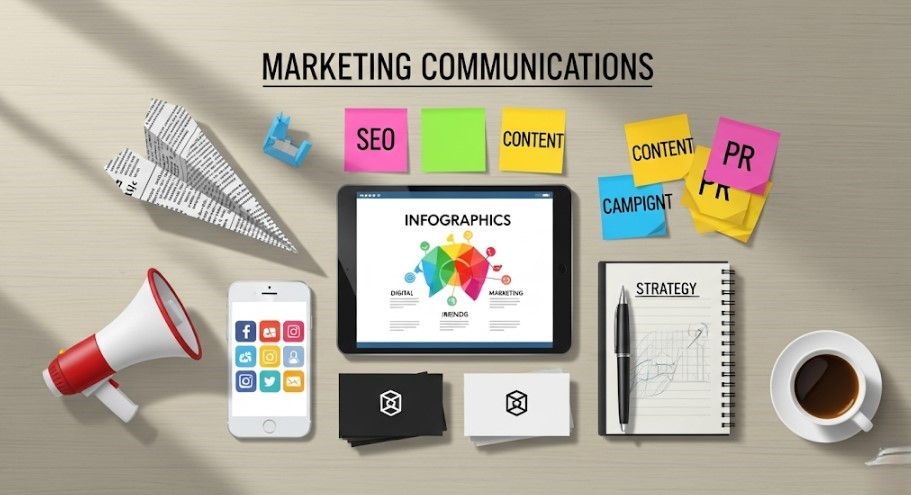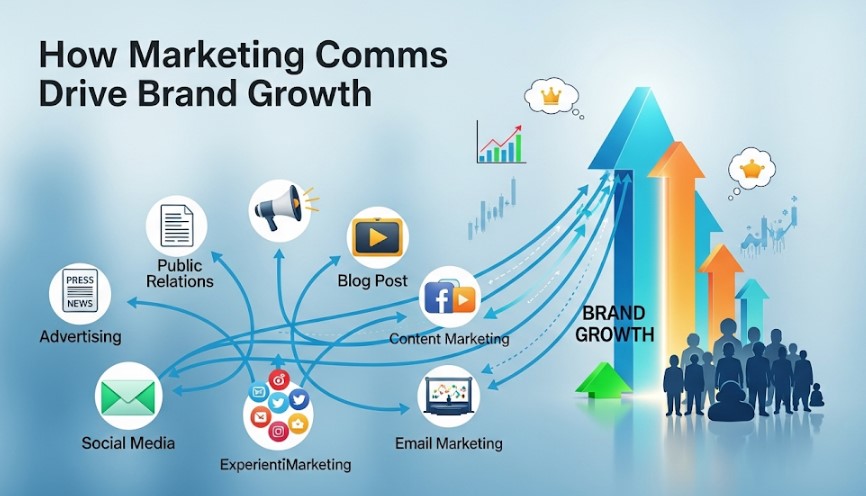A strong brand is one of a company’s most valuable assets. Think of iconic names like Apple, Nike, or Coca-Cola. These brands do more than just sell products; they evoke emotions, represent a lifestyle, and build lasting relationships with their customers. But this level of recognition doesn’t happen by accident. It’s the result of a deliberate and consistent strategy, with marketing communications at its core.
Effective marketing communications are the engine that powers brand growth. It’s the collection of all messages and media you deploy to communicate with the market. This includes everything from your advertising and social media posts to your website content and customer service interactions.
This article will explain how a well-executed marketing communications strategy can build brand awareness, foster customer loyalty, and ultimately drive sustainable growth for your business. We will explore the key components of this strategy and provide actionable steps to help you harness its power.
What Are Marketing Communications?

Marketing communications, often abbreviated as MarCom, encompass all the strategies, tools, and messages a company uses to connect with its target audience. The goal is to convey a clear, consistent, and compelling message about the company and its products or services.
The marketing communications mix traditionally includes several key elements:
- Advertising: Paid placements in media like television, radio, print, or online platforms.
- Public Relations (PR): Managing the spread of information between an organization and the public to build a positive image.
- Sales Promotion: Short-term incentives to encourage the purchase of a product, such as discounts, coupons, or contests.
- Direct Marketing: Communicating directly with targeted customers through mail, email, or telephone.
- Personal Selling: Face-to-face communication between a sales representative and a potential customer.
- Digital Marketing: Using online channels like social media, search engines, content marketing, and email to reach audiences.
A successful strategy integrates these elements to create a unified brand voice across all touchpoints.
The Role of Marketing Communications in Building a Brand
A brand is more than a logo or a catchy slogan; it’s the sum of all experiences a customer has with your company. Marketing communications play a pivotal role in shaping these experiences and perceptions. Here’s how.
Establishing Brand Awareness and Recognition
Before a customer can choose your brand, they need to know it exists. Marketing communications are fundamental to building awareness. Through consistent advertising, social media engagement, and public relations, you can introduce your brand to a wider audience.
The key is consistency. When your messaging, visuals, and tone are uniform across all channels, it helps solidify your brand in the minds of consumers. Over time, this repetition builds familiarity and recognition. When a potential customer sees your logo or hears your tagline, they should instantly connect it with your company and what you stand for.
Crafting a Strong Brand Identity
Your brand identity is the personality of your business. Are you innovative and modern, or traditional and reliable? Fun and quirky, or serious and professional? Marketing communications help define and project this identity.
The language you use in your ads, the imagery on your website, and the stories you share on social media all contribute to this persona. For example, a luxury car brand will use sophisticated language and sleek visuals to convey exclusivity and quality. In contrast, a budget-friendly snack company might use playful and colorful messaging to appear fun and accessible. By carefully crafting these communications, you can build an identity that resonates with your ideal customer.
Building Trust and Credibility
Trust is the foundation of any strong customer relationship. Consumers are more likely to buy from brands they perceive as credible and trustworthy. Marketing communications can help build this trust in several ways.
Content marketing, for instance, allows you to showcase your expertise by providing valuable and informative content through blog posts, whitepapers, or webinars. Customer testimonials and case studies offer social proof, demonstrating that others have had positive experiences with your brand. Public relations efforts that secure positive media coverage can also significantly boost your credibility. When customers see your brand as a reliable source of information and quality, they are more likely to become loyal advocates.
Differentiating from the Competition
In a crowded marketplace, standing out is essential. Marketing communications allow you to highlight your unique selling proposition (USP)—the one thing that makes you different from and better than your competitors.
Is your product more durable? Is your customer service more responsive? Do you use sustainable materials? Whatever your differentiator is, your messaging should consistently emphasize it. A clear and compelling USP helps customers understand why they should choose you over other options. This differentiation is crucial for carving out a distinct position in the market and attracting customers who value what you uniquely offer.
Creating a Powerful Marketing Communications Strategy

Now that we understand the importance of marketing communications, how do you create a strategy that drives brand growth? Here are four essential steps.
1. Define Your Target Audience
You can’t communicate effectively if you don’t know who you’re talking to. Start by creating detailed buyer personas for your ideal customers. Understand their demographics, needs, pain points, and media consumption habits. This knowledge will help you tailor your messages and choose the right channels to reach them. For example, a younger audience might be more receptive to content on TikTok and Instagram, while a professional audience may prefer LinkedIn and industry publications.
2. Develop a Consistent Brand Message
Your core message should be clear, concise, and consistent across all platforms. This message should encapsulate your brand’s promise and value proposition. Every piece of communication—from a tweet to a television ad—should reinforce this central theme. A consistent message prevents customer confusion and builds a strong, unified brand identity. Create brand guidelines that outline your tone of voice, visual style, and key messaging points to ensure everyone on your team is aligned.
3. Integrate Your Marketing Channels
An integrated marketing communications (IMC) approach ensures that all your marketing efforts work together harmoniously. Instead of operating in silos, your advertising, PR, social media, and other channels should complement and reinforce one another. For example, a PR campaign that generates media buzz can be supported by social media posts that share the coverage and a sales promotion that capitalizes on the increased attention. This synergy amplifies your message and creates a more impactful customer experience.
4. Measure and Adapt
Marketing is not a “set it and forget it” activity. It’s crucial to track the performance of your communications and make adjustments based on the data. Use analytics tools to monitor key metrics like website traffic, conversion rates, social media engagement, and brand mentions. This data will reveal what’s working and what isn’t, allowing you to optimize your strategy for better results. Be prepared to adapt to changing market trends and customer feedback to keep your brand relevant and effective.
Your Blueprint for Brand Growth
Marketing communications are not just a promotional tool; they are a strategic asset for building and growing a powerful brand. By creating awareness, shaping identity, building trust, and differentiating from the competition, a well-executed MarCom strategy lays the groundwork for long-term success.
Start by deeply understanding your audience, crafting a consistent message, integrating your channels, and continuously measuring your impact. By investing in a thoughtful and strategic approach to marketing communications, you can turn your company into a brand that customers not only recognize but also love and trust.




